Top Links
Journal of Stem Cells and Clinical Practice
Human Induced Pluripotent Stem Cells Derived from A Patient with Sporadic Alzheimer's Disease Exhibit Altered Neuronal Proliferative Capacity
Copyright: © 2015 Chung H. This is an open-access article distributed under the terms of the Creative Commons Attribution License, which permits unrestricted use, distribution, and reproduction in any medium, provided the original author and source are credited.
Related article at Pubmed, Google Scholar
We generated two hiPSC clones from a patient with sporadic late-onset alzheimer's disease (AD-iPSCs), which expressed typical undifferentiated markers and passed standard pluripotency assays. Genome-wide microarray analysis revealed that AD-iPSCs were highly similar to control hiPSCs and hESCs, albeit with some noticeable differences in few genes, viz.: DNAJC15, GRPR, NAIP and SNORD116-18. Several other biomarkers were differentially expressed in AD-iPSC clones which have been implicated in memory impairment and AD. Furthermore, well characterized familial (APP, PSEN1, PSEN2) and non-familial (A2M, APOE, GAP43, MAOA, MPO, PLAT, PLAU, SORL1, SNCA) AD-associated genes exhibited different expression patterns but were largely reset upon reprogramming into a pluripotent state. AD-iPSC clones could efficiently form neuroprogenitors via rosette formation but one of the two AD-iPSC clones exhibited a lower proliferation rate as determined by EdU incorporation assays. Further analysis revealed this lower proliferation was due to an increase in apoptotic gene expression. The data suggest that hiPSCs could be good candidates for AD modeling and may represent an in vitro alternative to studying disease mechanisms, drug discovery and toxicological studies. Further studies are required to ascertain the significance of the resetting of disease specific genes caused by reprogramming as seen in this study
Keywords: Alzheimer's disease; Pluripotent stem cells; pluripotency assays; AD-iPSCs
Alzheimer's disease (AD) is a neurodegenerative disorder associated with the loss of neurons that are vital for memory and other cognitive functions [1]. Current treatments have limited benefits and with the number of affected people expected to quadruple by 2050, effective therapies are required. Our current understanding of AD comes from diverse sources including neuronal cell lines [2-5], transgenic rodent models [6,7] and primary neuronal cell cultures derived from them [8]. However, candidate proteins known to be involved in the disease pathology may exhibit species-specific biochemical and functional characteristics, thereby providing only an imperfect human representation. Therefore it is important to develop alternative models that correctly recapitulate the complex pattern of proteins in human AD.
Pluripotent stem cells may be good 'disease models' because of their unique capacity to differentiate and self-renew and their developmental representation of early stages of life. Generation of disease-specific human embryonic stem cell (hESC) lines from pre-implantation genetic diagnosed (PGD) embryos is limited by their availability. The genetic engineering of existing hESC lines is also possible but these present technical difficulties. The recent production of induced pluripotent stem cells (iPSCs) offers a potential solution as these cells can be produced from patient skin with a simple transduction of four genes (OCT4, KLF4, SOX2, CMYC) [9]. Diseased-specific iPSCs have been generated for several disorders including Spinal muscular atrophy, Long-QT syndrome and Huntington's disease as reviewed by Sidhu [10], all of which demonstrated genetic and phenotypic differences in the relevant differentiated cell type(s) when compared to control healthy iPSCs derived from un/related individuals. These and other recent developments in sporadic cases of Alzheimer's disease [11,12] provide unprecedented advantages for drug discovery and providing further insight into disease etiology.
AD is generally diagnosed by cognitive impairment/dysfunction and functional impairment, with an increasing emphasis on biomarkers, and ultimately through histological analysis of post mortem brains. Most patients with AD have a late-onset sporadic form of the disease. Environmental factors, vascular risk factors, presence of Apolipoprotein ε4 (APOE4) allele, and some other genetic polymorphisms all greatly increase a person's susceptibility to sporadic AD, as reviewed by Taupin [13].
In the present study we have generated AD-iPSC clones from a sporadic female AD patient with strong clinical symptoms and performed a genome-wide transcriptome analysis with control pluripotent cells. Interestingly, several potential biomarkers implicated in memory impairment and AD were differentially expressed. This suggests that AD-iPSCs may provide an alternative in vitro model to study the underlying mechanisms of AD.
This study was conducted in accordance with the University of New South Wales (UNSW), Human Research Ethics Committee (HREC) approvals (HREC # 08037).
Human dermal fibroblasts were isolated from a punch skin biopsy from the female patient clinically diagnosed sporadic case of Alzheimer's disease with APOE α4/4. Fibroblasts were cultured in DMEM media supplemented with 10% FBS, Penicillin/streptomycin and Glutamax for 2-3 weeks. At passage 2-5, 100,000 fibroblasts were transduced with a polycistronic lentiviral vector encoding for genes; OCT4, KLF4, SOX2, CMYC under a constitutive promoter [14]. At day 5, transduced cells were harvested and seeded onto irradiated human fetal fibroblast feeder layers in hESC maintenance media (KO-DMEM supplemented with 20% SR, Glutamax, Penicillin/streptomycin, non-essential amino acids, Insulin transferrin selenium, β-mecaptoethanol). Daily media changes were performed using hESC maintenance media supplemented with 10 ng/ml bFGF. Control iPSCs were derived in a similar fashion using human fetal fibroblasts. Control (Co-) and AD-iPSCs were later transferred to a feeder-free system using hESC-qualified MatrigeTM(BD Biosciences) coated plates and mTeSRTM1 media (StemCell Technologies), according to manufacturer's protocol. All reagents were purchased from Life Technologies unless otherwise stated.
Neuroprogenitor differentiation was carried out following [15] slight modifications to Zhang's et al. protocol [16]. Briefly, confluent wells of pluripotent stem cells were subjected to 1 mg/ml dispase treatment for 20-30 min at 37 °C (or until intact colonies 'lifted' off) and further cultured for 4 days in mTeSRTM1 media in low adherent culture plates. Spherical aggregates were cultured for a further 3 days in neural induction media (DMEM/F12 supplemented with N2 (1%), non-essential amino acids and heparin). Aggregates were then transferred to laminin-coated (~20 μg/ml) plates for a further 8 days. Partial media changes were performed every other day. Neural rosette-like structures were observed at the end of 15 days induction and subjected to 1 mg/ml dispase treatment for 5-10 min. Gentle trituration allowed the dislodgement of the rosette-like structures and the cell suspension was transferred to low adherent culture plates in neural maintenance media (neural induction media supplemented with B27 (1%) and 20 ng/ml bFGF). After overnight culture, floating aggregates were transferred to a new well, hence selecting out the attached neuroepithelial cells. Floating aggregates were propagated as neurospheres and were passaged on a 2-3 weekly basis by mechanical dissociation. Partial media changes were performed every other day.
100 ng of total RNA from hESCs and iPSCs were labeled and hybridized onto Affymetrix Human GeneChip® Gene 1.0 ST arrays (Santa Clara, USA) according to the manufacturer's instructions at the Ramaciotti Centre for Genomics (UNSW, Australia). RMA normalized data [17] was subjected to one-way ANOVA to look for differential gene expression between cell lines (Partek Genome Suite v6.5). A False Discovery Rate (FDR) of 0.05 was used. Candidate genes were functionally annotated according to Gene Ontology (GO) terms [18].
Hierarchical clustering was carried out to look for possible co-regulation of significant differentially expressed candidate genes based on Euclidean and complete linkage distances using MeV 4.6.2 [19]. Further analysis to highlight Alzheimer's disease related genes was carried out by obtaining the gene list from SABiosciences-curated pathways (Maryland, USA).
Total RNA was extracted using TRIzol® and 1 μg was reverse transcribed to cDNA using SuperScript® III kit with random hexamers. Genes of interest were quantitatively detected using SsoFast™ EvaGreen® supermix (BioRad) and relative expression calculated using Pfaffl's methods [20]. All reagents were purchased from Life Technologies following manufacturer's instructions unless stated otherwise. Biological triplicates were used.
Cell samples were fixed in 4% paraformaldehyde (Sigma-Aldrich) for 20 min, permeablized with 0.1% Triton X-100/PBS for 10 min and blocked with 2% BSA/PBS for 1 h. Cell samples were stained with appropriate primary antibodies in blocking solution overnight at 4 °C and AlexoFluor® conjugated secondary antibodies (Life Technologies) for 30 min at room temperature. Cells were counterstained with DAPI (Life Technologies). Primary antibodies: SOX17 (R&D Systems), OCT4, NANOG, SSEA4, TRA160 and SMA (Abcam), βIII tubulin (Covance), NESTIN (Millipore), PAX6 and SOX1 (Santa Cruz).
Using our previously optimized procedure [14] two iPSC clones were established and designated as Alzheimer's disease-specific lines, i.e. ALZ1 and ALZ7, and these were subcultured on a 5-7 day basis using TrypLE Select for 5-10 passages before being transferred to a feeder-free system consisting of MatrigelTM coated plates and mTeSRTM1 medium [21]. Colonies of AD-iPSCs were morphologically indistinguishable from control (Co) iPSC and hESCs (Figure 1A).
Further characterization revealed that AD-iPSCs were genetically and phenotypically indistinguishable from control hESC/hiPSCs. Hypomethylated OCT4 promoter regions indicated successful reprogramming of fibroblasts (24.4% vs. 66.7%, Figure 1B). Using immunofluorescence staining, feeder-free cultures of AD-iPSCs typically expressed undifferentiated pluripotent markers OCT4, NANOG, SSEA4 and TRA160 (Figure 1C). Quantitative gene expression analyses of pluripotency-associated genes were not significantly different across pluripotent cell lines. In contrast, parental fibroblasts (AD-Fib) expressed extremely low levels of NANOG, OCT4, SOX2 and GDF3, but had similar levels of CMYC and KLF4 expression (Figure 1D). Furthermore, extended feeder-free culture showed no chromosomal abnormalities in ALZ1/ALZ7 as determined by standard G-banding karyotypic analysis (Figure 1E).
Pluripotency of AD-iPSCs was examined through in vitro embryoid body formation and in vivo teratoma formation assays. Cells and tissue structures generated were representative of the three embryonic germ layers, respectively (Figure 2A-C). DNA fingerprinting analysis confirmed the genetic identity of AD-iPSCs as being derived from AD-Fib and not from cross-contamination with other cell lines ( Figure S1).
The transcriptome of AD-iPSCs was similar to Co-iPSCs and hESCs, as determined by whole-genome transcript analysis using Affymetrix Human Gene 1.0 ST arrays. Scatterplots and correlation coefficients revealed that on the 33,297 transcripts, ADiPSCs, Co-iPSCs and hESCs were highly correlated with each other whereas minimal correlation was observed between fibroblasts and pluripotent cells (Figure S2A-B). A heat map was generated based on 4,532 genes that were differentially expressed (False discovery rate (FDR)-corrected P value < 0.05 and fold change > ±2), between fibroblast and pluripotent cell populations (Figure S2C). Overall, this indicated that AD-iPSCs were highly similar to Co-iPSCs and hESCs in terms of global gene expression.
However, some genes were differentially expressed between control (hESC/Co-iPSC) and disease (AD-iPSC) pluripotent cell populations. Based on a FDR-corrected P value < 0.05 and fold change > ±1.3, a total of 335 and 160 genes were further analyzed in [AD-iPSC vs. Co-iPSC] and [AD-iPSC vs. hESC], respectively. By conducting gene ontology (GO) enrichment analysis, genes with common biological function were ranked based on the number of times a gene was enriched for a particular function. Immune response and neuronal developmental GO terms were significantly enriched (i.e. enrichment score > 3) in AD-iPSCs, whereas cell junction assembly and maintenance of DNA repeat element GO terms were enriched in control cells (Figure S3A-B). Furthermore, 5 genes exhibited > 3 fold change between AD-iPSCs and hESCs/Co-PSCs; DNAJC15, GRPR, HLA-DQB1, NAIP and SNORD116-18 (Figure 3A-B). Both DnaJ (Hsp40) homolog, subfamily C, member 15 (DNAJC15) and Major histocompatibility complex, class II, DQ beta 1 (HLA-DQB1) have been implicated with functions of immunological response and these genes were highly expressed in AD-iPSCs, which was consistent with GO enrichment analysis (Figure S3). Interestingly, gastrin releasing peptide receptor (GRPR) was also significantly upregulated in AD-iPSCs and has been implicated in AD and other neurological disorders [22]. In contrast, small nucleolar RNA, C/D box 116 (SNORD116-18) and neuronal apoptosis inhibitory protein (NAIP) were significantly downregulated in AD-iPSCs
We further analyzed the expression of four of these genes using quantitative RT-PCR (qRT-PCR) (Figure 3C). Surprisingly, these genes were not significantly different from each control (E2, iPS65) or diseased (ALZ1, ALZ7) cell lines, which is in contrast to the microarray data. In fact, both NAIP and SNORD116-18 were observed to have an opposite trend in gene expression. This was most probably due to the design of the primers used in qRT-PCR, which targeted multiple regions of NAIP (i.e. chr5:69404269-69404333, chr5:70279736-70279800 and chr5:70404622-70404686 on chromosome 5q13.2) and multiple 61 bp regions of the SNORD116 gene cluster (chr15:25327944-25328004, chr15:25328764-25328824, chr15:25330561-25330621, chr15:25331703-25331763, chr15:25332838-25332898, chr15:25333980-25334040, chr15:25335099-25335159 on chromosome 15q11-13).
Furthermore, well characterized familial AD-associated genes (APP, PSEN1, PSEN2) [23,24] and non-familial (A2M, APOE, GAP43, MAOA, MPO, PLAT, PLAU, SORL1, SNCA) [13,25-27], exhibited different expression patterns, as determined by the microarrays but were largely reset upon reprogramming into a pluripotent state (Figure S4).
We next examined whether AD-iPSCs could develop into neuronal lineages by following a slightly modified neural induction protocol [16]. By day 10 of neural induction, PAX6+ and SOX1+ cells were apparent among the attached clusters (data not shown). We were able to generate neurospheres in hESC, Co-iPSC and AD-iPSC populations through mechanical dissociation of neural rosettes formed at the end of a 15 day induction period (Figure 4A). Immunofluorescence analysis indicated that neuroprogenitors derived from control and disease cell lines stained positive for NESTIN, PAX6 and SOX1 (Figure 4B). Gene expression analysis indicated that NESTIN and SOX2 were minimally upregulated (< 10 fold), whereas PAX6 and SOX1 expression were upregulated up to ~10,000 fold (Figure 5A). NANOG was significantly downregulated in all neuroprogenitor lines as expected (P < 10-6) and was not significantly different between cell lines. Interestingly, only E2-neuroprogenitors exhibited statistically significant upregulated gene expression values in all neuronal genetic markers analyzed (P < 0.05), indicating that hESC differentiation protocols were more reproducible, whereas hiPSC differentiation were more variable (i.e. ranging between 100 to 10,000 fold). Overall, both protein expression and gene expression profiling in control and disease hiPSCs of neuronal markers (i.e. NESTIN, PAX6, SOX1, SOX2) indicated no significant differences in neuroprogenitor formation (Figure 5A-C).
Neuroprogenitors or neural stem cells offer the potential to self-renew and differentiate into multiple neural/glial lineages. Therefore, we investigated the proliferation rate of AD-iPSC derived neuroprogenitors using 5-ethynyl-2´-deoxyuridine (EdU) incorporation assays. Interestingly, a significantly lower percentage of EdU+ cells were found in ALZ7-neuroprogenitors but not ALZ1-neuroprogenitors compared with control cells (Figure 4C, 5B). We next investigated whether this lower proliferation rate was due to an increase in apoptosis. Therefore we examined the expression of several key apoptosis-related genes. Amongst, CASP3, CASP9, CDKN1A (p21), MDM2 and TP53 (p53), only TP53 and CAPS9 genes were significantly different with control and ALZ1 derived neuroprogenitors (Figure 6A).
Furthermore, the 4 candidate genes DNAJC15, GRPR, NAIP and SNORD116-18 isolated as being specific to AD-iPSCs, were also analyzed at the neuroprogenitor stages. Interestingly, none of the neuroprogenitor cell lines exhibited significant differences in gene expression (Figure 6B).
Human iPSCs have been generated for many degenerative diseases, some of which displayed abnormal phenotypes following directed differentiation [28,29], while some were physiologically functional [30,31]. In the present study, we generated hiPSCs from a female sporadic AD patient and these cells were phenotypically indistinguishable from undifferentiated control hiPSCs and hESCs. Although global transcriptomic analysis revealed high similarity between disease and control pluripotent cells, there were a small number of genes that were differentially regulated, some of which have been implicated in neurological disorders.
Although neuronal apoptosis inhibitory protein (NAIP) was ~3 fold lower in AD-iPSCs than Co-iPSCs/hESCs (as determined by microarray analysis), qRT-PCR detected an equal amount of NAIP transcript in all undifferentiated cell lines. This was probably due to the design of the oligonucleotide primers which we later confirmed to amplify 2 other regions on the NAIP transcript. As the name suggests, NAIP is an anti-apoptotic protein and has been implicated in motor neuron apoptosis in spinal muscular atrophy [32]. Individuals with Down syndrome also exhibit decreased expression of NAIP in their cortex [33], and they are genetically predisposed to AD. Furthermore, NAIP is inversely related to paired helical filament-1 protein in brain tissue of AD individuals [34], which may indicate the presence of NFT pathology in non-familial AD-iPSCs.
Gastrin releasing peptide receptor (GRPR) is a G-protein coupled receptor and has been extensively studied in cancers [35] and expressed in multiple regions of the central nervous system, including the hippocampus [36], a region important for episodic memory. It is increasingly evident that GRPR is associated with several neurological disorders, including AD, as reviewed in Roesler et al. [22]. The higher expression of GRPR in AD-iPSCs compared with their undifferentiated counterparts (~3 fold and ~10 fold in microarray and qPCR analysis, respectively), could arguably be due to an additional transcript copy on the X chromosome. However, since female hiPSC lines have been shown to retain their inactive X chromosome even after reprogramming into a pluripotent state [37], high GRPR levels may in fact be associated with AD. Furthermore, the increased expression may suggest susceptibility of receptor activation and subsequent long-term memory impairment [38], leading to AD-associated memory loss.
DNAJC15 (also known as MCJ, DNAJD1) is normally silenced in the majority of carcinoma cell lines via DNA hypermethylation and loss of DNAJC15 causes resistance to chemotherapeutic agents in vitro [39,40]. Co-Fib readily expressed DNAJC15, but it was absent from Co-iPSCs and its neuroprogenitor derivatives. Extensive epigenetic remodeling takes place during somatic cell reprogramming [41,42], and the presence of multiple H3K27Ac regions (Histone 3 Lysine 27 acetylation, https://genome.ucsc.edu), within the DNAJC15 transcript indicates repressive (and also stable) epigenomic modification(s) to that particular genomic region, leading to gene silencing. Surprisingly, E1 but not E2 cell lines also exhibited this phenomenon. Therefore fetal derived hiPSCs (i.e. Co-iPSCs) may be more resistant to drug evaluations and subsequently may not be suitable candidates for high throughput screening (HTS) for drug discovery and/or toxicology studies.
Small nucleolar RNA, C/D box 116 (SNORD116) is a non-coding RNA region that resides in the SNRPN transcript and contains 29 tandem repeated copies of the SNORD116 gene (1-29, https://genome.ucsc.edu). Measuring SNORD116-18 was difficult since the qPCR primers targeted multiple regions within SNORD116 and subsequently contradicted results from the microarray analysis. Though results were inconclusive, SNORD116 was reportedly expressed at low levels in hiPSCs derived from Prader-Willi syndrome patients – a neurological disorder caused by gene deletions [43]. This indicates a possible link between AD and Prader-Willi syndrome. Whether SNORD116-18 is involved with neurological diseases or bears a consequence of somatic cellular reprogramming, remains to be defined.
Control and disease cells could differentiate into neuroprogenitors, however variable gene expression patterns were observed in our hiPSC-derived neuroprogenitors, which were similar to other differentiation protocols [44-46]. This suggests that although hiPSCs can differentiate into multiple cell types like hESCs, their differential variability between cell lines (or in our case, within the same cell line) is statistically more prominent. Interestingly, one of the AD-iPSC-derived neuroprogenitor lines (i.e. ALZ7) exhibited a significantly lower proliferation rate when compared with other neuroprogenitor lines. With further analysis, we observed atypical TP53 and CASP9 gene expression, which was indicative of apoptosis. This may suggest potential apoptotic mechanism(s) are involved in the intermediate stages of AD, in addition to the ones reviewed by Crews and Masliah [47]. This would subsequently compromise neuronal development, correlating to individuals diagnosed with early onset non-familial AD.
Additionally, candidate genes we classified to be specific to sporadic AD based on differential expression (i.e. DNAJC15, GRPR, NAIP, SNORD116-18) were not significantly different between neuroprogenitor lines. Overall, differentiation of disease-specific hiPSCs into progenitor cell types was not significantly different to controls, and this was observed in several other studies [10,48]. Whether specific neuronal deficits or abnormal expression of our analyzed genes/proteins appear at a more terminal cell derivative (e.g. basal forebrain cholinergic neurons, glial) remains to be determined.
We have until now defined disease-specific hiPSCs based on the patient who donated the skin. For monogenic disorders, this is simple to characterize, but for complex diseases such as sporadic Alzheimer's, the disease specificity is defined by both patient phenotype and genotype, as with this study. Furthermore, environmental stressors and epigenetic influences also contribute to the difficulties in replicating faithfully in an in vitro model. Another limiting factor in the present study was the lack of an appropriate hiPSC control cell line. The ideal scenario would be to have unaffected sib-pair that can act as an internal control due to similar genetic background. To adequately study the pathophysiology of AD, multiple AD-iPSCs should be derived from patients with various clinical symptoms in order to reflect early/late onset and/or familial/sporadic versions of the disease.
We believe that the AD-iPSCs generated in this study is a representative disease-specific cell line, which will be an invaluable in vitro model to study the molecular mechanisms in AD and subsequently, for high throughput screening. However, before such application, it will be useful to further differentiate AD-iPSCs into mature neurons, such as cholinergic lineages of the basal forebrain as described elsewhere [15,49] to determine whether there is impairment during neuronal development. Because the two AD-iPSC lines exhibited contradicting outcomes, it is recommended that future disease modeling studies using hiPSCs should attempt to analyze three or more cell lines from any individual for accurate conclusions.
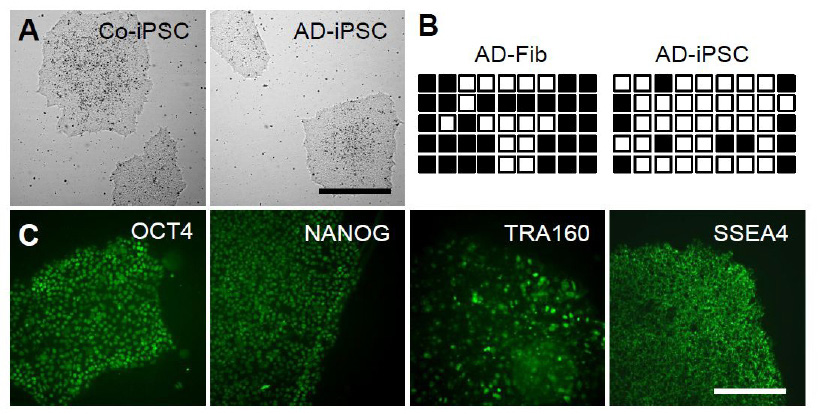 |
| Figure 1: Characterization of Alzheimer's disease specific hiPSCs (AD-iPSCs). A) Colony morphologies of control and diseased hiPSCs under feeder-free conditions. Scale = 500 μm. B) OCT4 promoter DNA methylation analysis using bisulfite sequencing. (Open squares: Unmethylated, closed squares: Methylated). C) Immunofluorescence staining of typical undifferentiated nuclear/surface markers, OCT4, NANOG, TRA160, SSEA4. Scale = 200 μm. D) Gene expression analyses of pluripotency related genes using quantitative PCR. *** P < 0.0005. E) Standard G-banding karyotypic analysis of AD-iPSCs after extended propagation under feeder-free conditions |
 |
| Figure 1: Preoperative spine MRI. (A) Sagittal lumbar T2 image showing extensive subarachnoid hemorrhage with lumbosacral flow void and S1-S2 lipoma; (B) T2 Axial view of large hematoma with significant compression of the lumbar dural sac; (C) T2 sagittal view of thoracic extension of the hematoma, with significant spinal cord compression at D4-D6; (D) Angiography of lumbosacral AVM responsible for hemorrhage prior to embolization. |
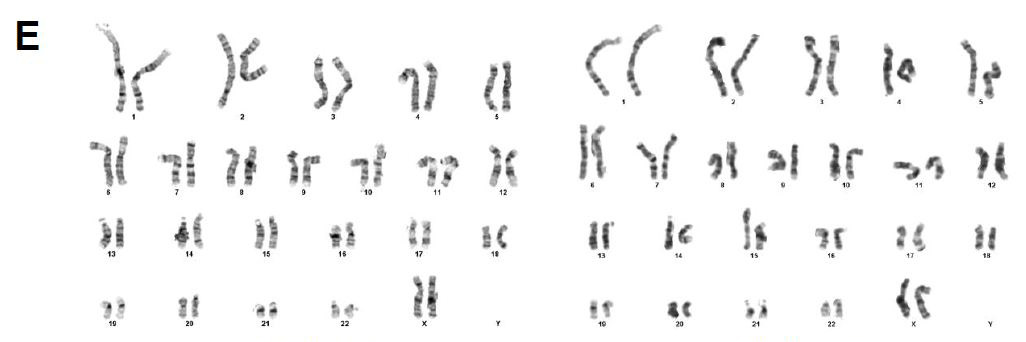 |
| Figure 1: Preoperative spine MRI. (A) Sagittal lumbar T2 image showing extensive subarachnoid hemorrhage with lumbosacral flow void and S1-S2 lipoma; (B) T2 Axial view of large hematoma with significant compression of the lumbar dural sac; (C) T2 sagittal view of thoracic extension of the hematoma, with significant spinal cord compression at D4-D6; (D) Angiography of lumbosacral AVM responsible for hemorrhage prior to embolization. |
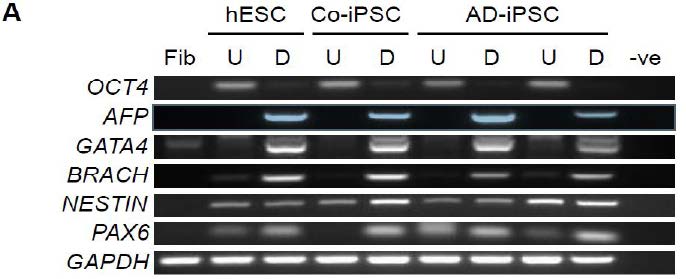 |
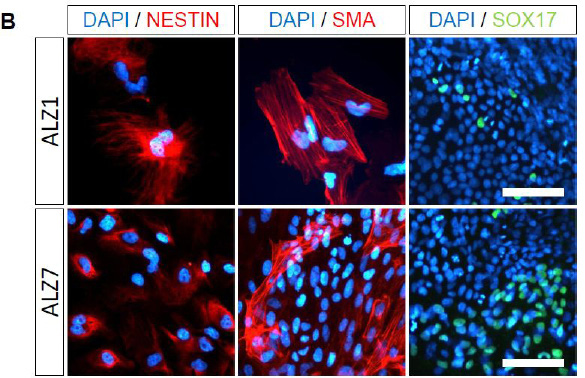 |
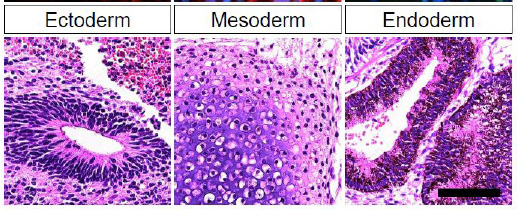 |
| Figure 2: In vitro and in vivo analysis of pluripotency of AD-iPSCs. A) Gene expression analysis of early lineage markers in the undifferentiated (U) and embryoid body differentiated (D) states of pluripotent cell lines. OCT4: Pluripotency, AFP & GATA4: Endoderm, BRACHYURY (BRACH): Mesoderm and NESTIN & PAX6: Ectoderm. B) Immunofluorescence staining of early lineage markers after in vitro differentiation induced by embryoid body attachment in FBS containing media. C) In vivo teratoma formation assays were performed by intratesticular injection of AD-iPSCs into SCID mice. Representative tissues of the 3 embryonic lineages were observed. Scale = 50 μm |
 |
| Figure 3: Differentially expressed genes of control and disease pluripotent cell lines. A) Heatmap representation of the genes differentially expressed (Fold change > ±3) between control and diseased pluripotent lines. B) Graphical representation of the genes in A) based on microarray calculated values. Fold change displayed is representative of AD-iPSCs relatively to control cells. All values were significantly different. C) Gene expression analysis of four of these genes were confirmed by quantitative RT-PCR on E2 (hESC), iPS65 (Co-iPSC) and AD-iPSC lines. * P < 0.05 |
 |
| Figure 4: Neuroprogenitors derived from control and disease pluripotent cell lines. A) Morphological analysis of the neurospheres generated from dissecting out neural rosette-like structures. B) Neurospheres were dissociated into single cells and seeded onto laminin-coated dishes and stained positive for neural stem/progenitor markers; NESTIN, PAX6 and SOX1. C) EdU incorporation assays were performed to determine the proliferativ capacity of these neuroprogenitors. Scale = 200 μm |
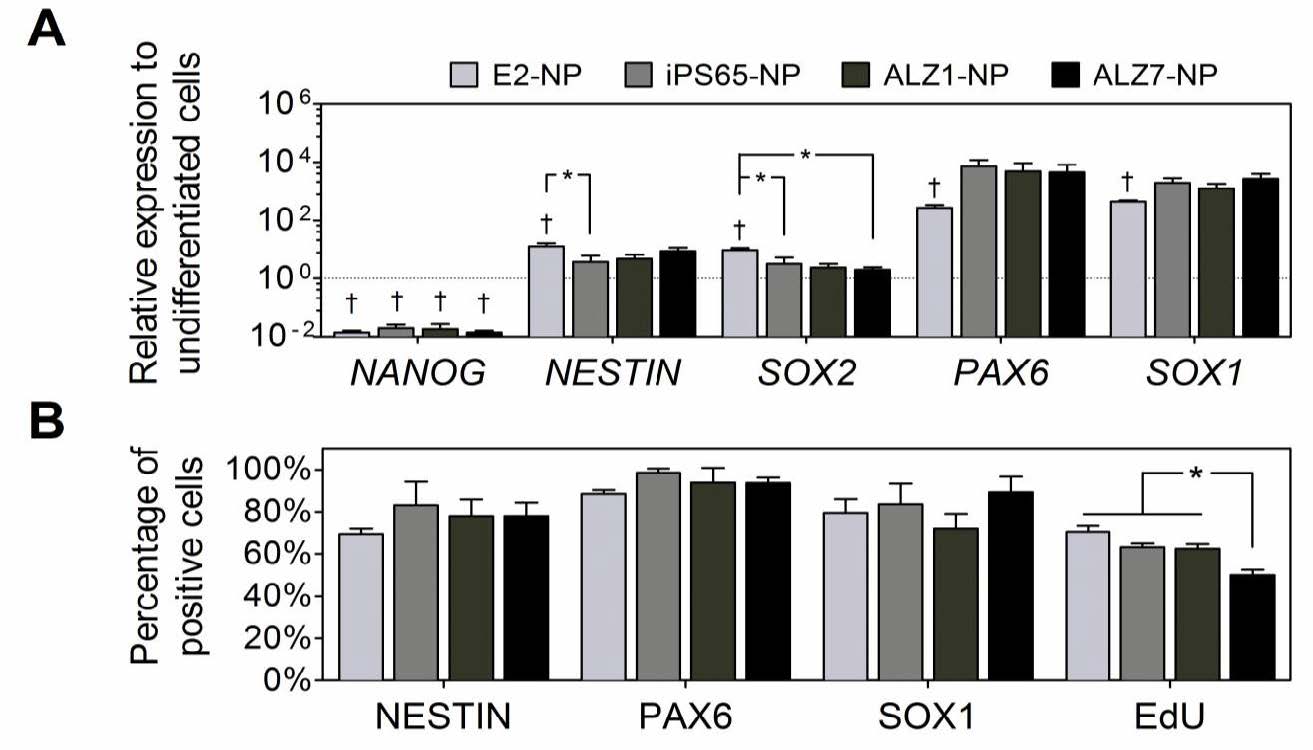 |
 |
| Figure 5: Analyses of AD-iPSC derived neuroprogenitors. A) Quantitative gene expression analysis of neuroprogenitors (NP). Markers include pluripotent (NANOG) and neural stem/progenitor genes (NESTIN, SOX2, PAX6, SOX1). B) Percentages of NESTIN+, PAX6+, SOX1+ and EdU+ cells represented in Figure 4B-C. Percentages were obtained from 9-12 random images from 3 independent biological experiments and calculated using pixel density using ImageJ software. *P < 0.05. C) Protein expression analysis of PAX6 and SOX1 using western blot. U: undifferentiated, NP: neuroprogenitor |
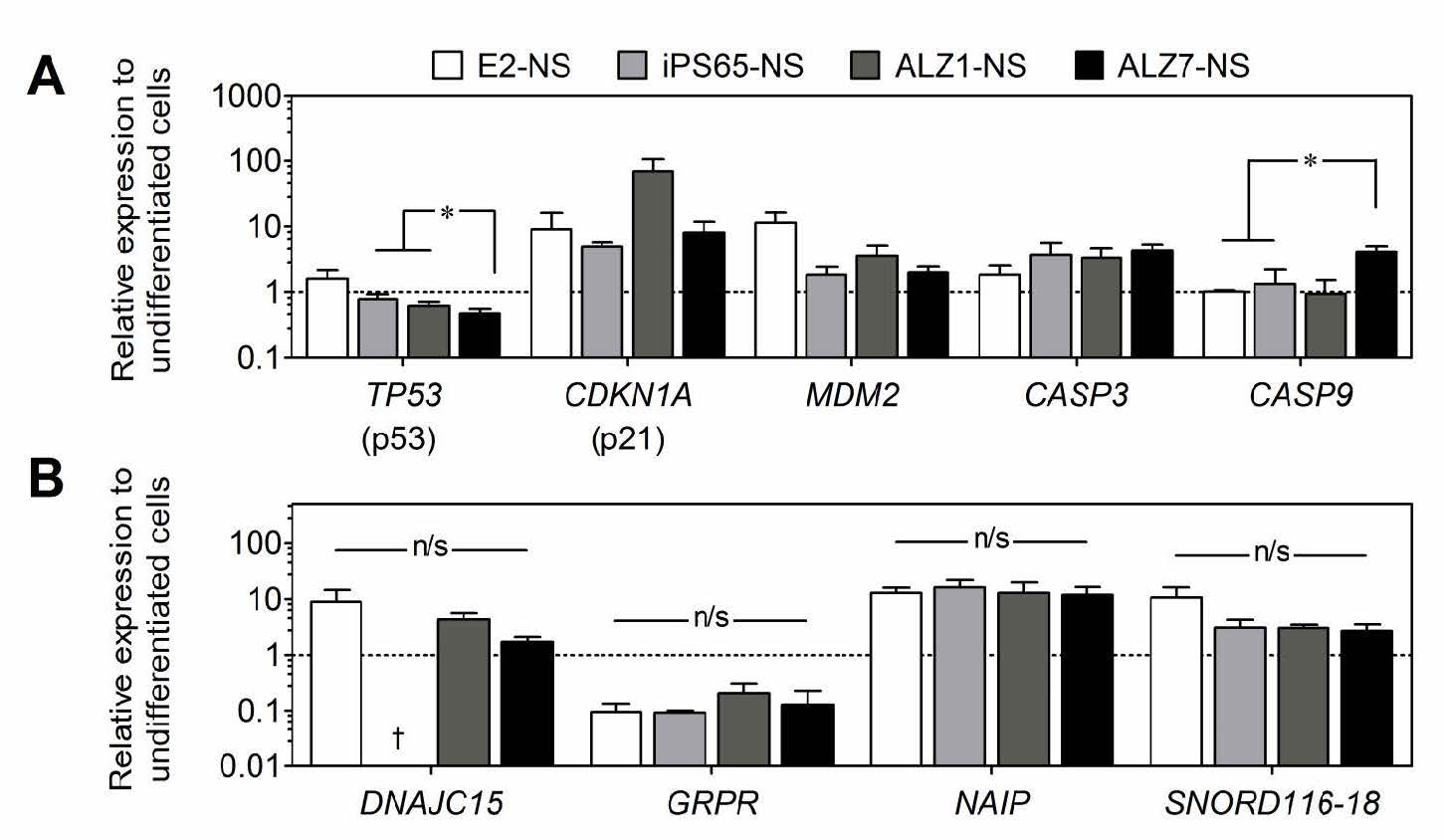 |
| Figure 6: Mechanisms for the lower proliferation rate of AD-iPSC derived neuroprogenitors. A) Quantitative gene expression analysis of apoptosisrelated genes; p53, p21, MDM2, CASP3 and CASP9. * P < 0.05. B) Analysis of candidate genes in neuroprogenitor lines that were differentially expressed between control and diseased pluripotent cell lines. n/s: non-significant. †No melt curves were present, indicating no PCR gene product |
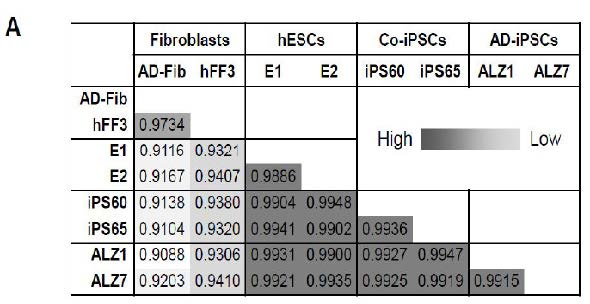 |
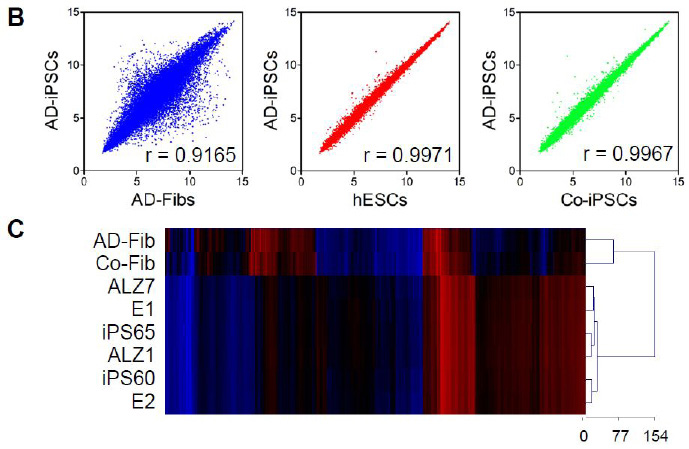 |
| Figure S2: Global expression across all cell types. A) Pearson's correlation coefficients were determined between control and disease parental fibroblasts and pluripotent cell lines. B) Scatterplots of the mean signal intensity values of AD-Fibs, hESCs (E1, E2), Co-iPSCs (iPS60, iPS65) and AD-iPSCs (ALZ1, ALZ7) C) Heatmap/dendogram of the 4,532 differentially expressed genes between fibroblasts and pluripotent cell populations. These genes were selected based on a FDR-corrected P value < 0.05 and acquiring at least > ±2 fold change |
 |
| Figure S2: Global expression across all cell types. B) Scatterplots of the mean signal intensity values of AD-Fibs, hESCs (E1, E2), Co-iPSCs (iPS60, iPS65) and AD-iPSCs (ALZ1, ALZ7) C) Heatmap/dendogram of the 4,532 differentially expressed genes between fibroblasts and pluripotent cell populations. These genes were selected based on a FDR-corrected P value < 0.05 and acquiring at least > ±2 fold change |
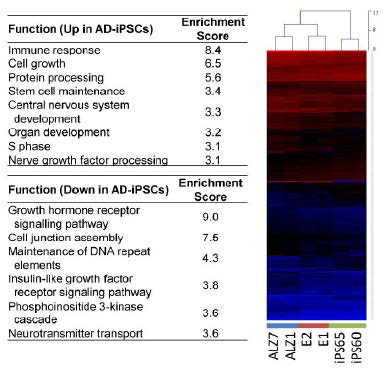 |
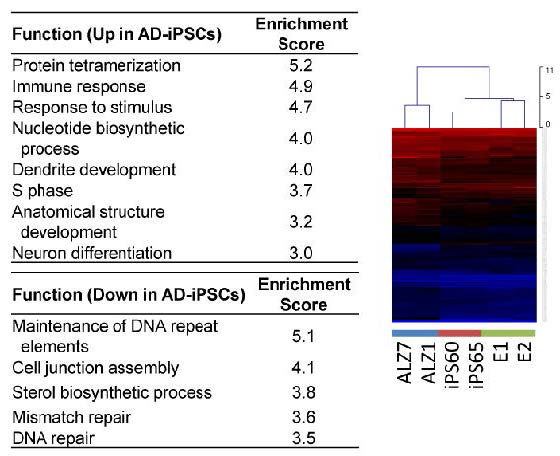 |
| Figure S3: Differentially expressed genes between control and disease pluripotent lines. A) 335 genes were differentially expressed between AD-ipSCs vs. Co-iPSCs, and B) 160 genes between AD-iPSCs vs. hESCs. To determine overall biological functions, GO enrichment analysis was performed on genes that were up- or downregulated in a cell population. Functions with enrichment scores > 3 were considered significant. Heatmaps/dendograms were also generated for these two lists of genes, and surprisingly hESCs, Co-iPSCs and AD-iPSCs grouped separately from each other. |
 |
| Figure S4: Analysis of Alzheimer's disease related genes. AD-associated genes (obtained from SABiosciences) were analyzed separately and both familial and non-familial AD-related genes were displayed in these scatterplots |
 |
 |
| Figure 6: Patient is now able to stand straight with the aids of orthesis |
| STR marker | Cell line | ||||
|---|---|---|---|---|---|
| hESC | Co-iPSC | AD-Fib | AD-iPSC1 | AD-IPSC7 | |
| D8S1179 | 11, 15 | 10, 12 | 8, 15 | 8, 15 | 8, 15 |
| D21S11 | 30 | 28, 30 | 30 | 30 | 30 |
| D7S820 | 11, 12 | 9, 11 | 8 | 8 | 8 |
| CSF1PO | 12 | 10, 11 | 10, 12 | 10, 12 | 10, 12 |
| D3S1358 | 15, 16 | 14 | 16, 18 | 16, 18 | 16, 18 |
| TH01 | 6, 9 | 6, 9.3 | 9, 9.3 | 9, 9.3 | 9, 9.3 |
| D13S317 | 11, 12 | 12, 14 | 8, 10 | 8, 10 | 8, 10 |
| D16S539 | 11, 13 | 9, 11 | 11, 12 | 11, 12 | 11, 12 |
| D2S1338 | 19, 23 | 20, 24 | 19, 24 | 19, 24 | 19, 24 |
| D19S433 | 13, 14.2 | 14 | 13.2, 14 | 13.2, 14 | 13.2, 14 |
| vWA | 14, 18 | 16, 17 | 18 | 18 | 18 |
| TPOX | 8 | 8, 9 | 8, 10 | 8, 10 | 8, 10 |
| D18S51 | 13,15 | 12, 17 | 13, 20 | 13, 20 | 13, 20 |
| D5S818 | 12, 13 | 11 | 11 | 11 | 11 |
| FGA | 18, 19 | 19, 23 | 20, 25 | 20, 25 | 20, 25 |
| Figure S1: DNA fingerprinting analysis of cell lines. Genetic identity of AD-iPSC lines was confirmed through examining 15 short tandem repeat (STR) alleles of parental fibroblasts and pluripotent cell lines. All cell lines were of female origin | |||||






































